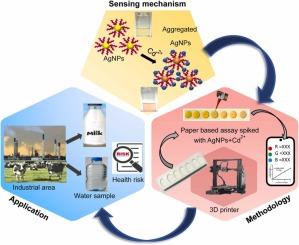基于智能手机的牛奶中镉的比色检测用于食品安全监测
IF 4.6
2区 农林科学
Q2 CHEMISTRY, APPLIED
引用次数: 0
摘要
本研究提出了一种基于智能手机的比色成像系统,该系统结合了3d打印平台上的纸质传感器,用于敏感和选择性地检测牛奶和水样中的镉离子(Cd 2 +)。传感探针使用蔗糖包覆的银纳米粒子(AgNPs/蔗糖),在与Cd 2 +相互作用后,其颜色从黄色变为红色,局部表面等离子体共振(LSPR)发生移位。通过UV-Vis, TEM, DLS, FTIR和XPS分析验证了这一点。此外,使用高斯16的密度泛函理论(DFT)证实了Cd 2⁺与AgNPs之间的配位。通过智能手机辅助的RGB图像分析实现定量,将Cd 2⁺的浓度与颜色强度相关联。该方法线性范围为0.05 ~ 3 µg/mL,检出限分别为0.02 µg/mL(成像法)和0.03 µg/mL(纸质法)。还对牛奶样本进行了非致癌性和致癌性健康风险评估。这种环保、低成本的方法使现场食品安全和环境监测成为可能。本文章由计算机程序翻译,如有差异,请以英文原文为准。

Smartphone-based colorimetric sensing of cadmium in milk for food safety monitoring
This study presents a smartphone-based colorimetric imaging system combined with a paper-based sensor on a 3D-printed platform for the sensitive and selective detection of cadmium ions (Cd²⁺) in milk and water samples. The sensing probe utilizes sucrose-capped silver nanoparticles (AgNPs/sucrose), which exhibit a visible color change from yellow to reddish and a shift in localized surface plasmon resonance (LSPR) upon interaction with Cd²⁺. This was validated by UV-Vis, TEM, DLS, FTIR, and XPS analyses. Additionally, density functional theory (DFT) using Gaussian 16 confirmed coordination between Cd²⁺ and AgNPs. Quantification was achieved via smartphone-assisted RGB image analysis, correlating Cd²⁺ concentration with color intensity. The method showed a linear range of 0.05–3 µg/mL and detection limits of 0.02 µg/mL (imaging) and 0.03 µg/mL (paper-based assay). Non-carcinogenic and carcinogenic health risk assessments for milk samples were also performed. This eco-friendly, low-cost approach enables on-site food safety and environmental monitoring.
求助全文
通过发布文献求助,成功后即可免费获取论文全文。
去求助
来源期刊

Journal of Food Composition and Analysis
工程技术-食品科技
CiteScore
6.20
自引率
11.60%
发文量
601
审稿时长
53 days
期刊介绍:
The Journal of Food Composition and Analysis publishes manuscripts on scientific aspects of data on the chemical composition of human foods, with particular emphasis on actual data on composition of foods; analytical methods; studies on the manipulation, storage, distribution and use of food composition data; and studies on the statistics, use and distribution of such data and data systems. The Journal''s basis is nutrient composition, with increasing emphasis on bioactive non-nutrient and anti-nutrient components. Papers must provide sufficient description of the food samples, analytical methods, quality control procedures and statistical treatments of the data to permit the end users of the food composition data to evaluate the appropriateness of such data in their projects.
The Journal does not publish papers on: microbiological compounds; sensory quality; aromatics/volatiles in food and wine; essential oils; organoleptic characteristics of food; physical properties; or clinical papers and pharmacology-related papers.
 求助内容:
求助内容: 应助结果提醒方式:
应助结果提醒方式:


